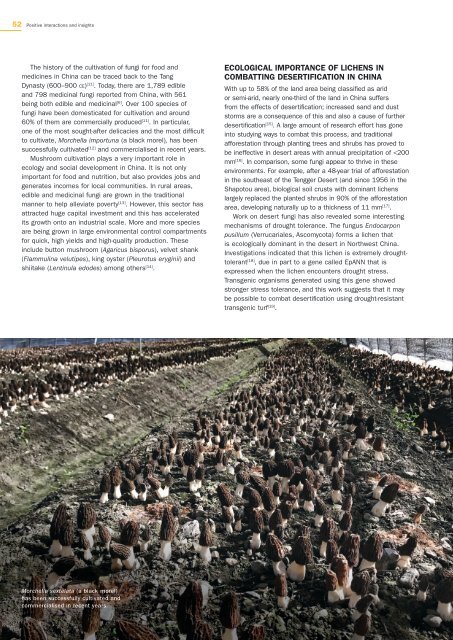gom1
Create successful ePaper yourself
Turn your PDF publications into a flip-book with our unique Google optimized e-Paper software.
52 Positive interactions and insights<br />
The history of the cultivation of fungi for food and<br />
medicines in China can be traced back to the Tang<br />
Dynasty (600–900 ce) [11] . Today, there are 1,789 edible<br />
and 798 medicinal fungi reported from China, with 561<br />
being both edible and medicinal [6] . Over 100 species of<br />
fungi have been domesticated for cultivation and around<br />
60% of them are commercially produced [11] . In particular,<br />
one of the most sought-after delicacies and the most difficult<br />
to cultivate, Morchella importuna (a black morel), has been<br />
successfully cultivated [12] and commercialised in recent years.<br />
Mushroom cultivation plays a very important role in<br />
ecology and social development in China. It is not only<br />
important for food and nutrition, but also provides jobs and<br />
generates incomes for local communities. In rural areas,<br />
edible and medicinal fungi are grown in the traditional<br />
manner to help alleviate poverty [13] . However, this sector has<br />
attracted huge capital investment and this has accelerated<br />
its growth onto an industrial scale. More and more species<br />
are being grown in large environmental control compartments<br />
for quick, high yields and high-quality production. These<br />
include button mushroom (Agaricus bisporus), velvet shank<br />
(Flammulina velutipes), king oyster (Pleurotus eryginii) and<br />
shiitake (Lentinula edodes) among others [14] .<br />
ECOLOGICAL IMPORTANCE OF LICHENS IN<br />
COMBATTING DESERTIFICATION IN CHINA<br />
With up to 58% of the land area being classified as arid<br />
or semi-arid, nearly one-third of the land in China suffers<br />
from the effects of desertification; increased sand and dust<br />
storms are a consequence of this and also a cause of further<br />
desertification [15] . A large amount of research effort has gone<br />
into studying ways to combat this process, and traditional<br />
afforestation through planting trees and shrubs has proved to<br />
be ineffective in desert areas with annual precipitation of

















